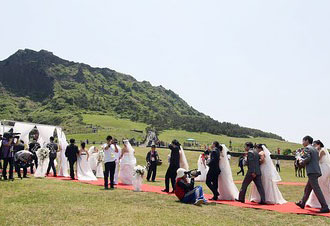Chinese investors are building Jeju’s biggest new developments and taking most of the island’s foreign investor visas.
The resort island of Jeju, which lies about 65 miles off the souwestern tip of South Korea, has become a favorite resort destination among travelers from China. Chinese made up nearly two-thirds of the 1.7 million foreigners who visited the island last year — a 600% growth over the 174,000 that visited in 2008.
A 2010 survey in China’s state-run Global Times ranked among the top three overseas resort islands, along with Hawaii and the Maldives. Last year it was ranked the top honeymoon destination by China’s Travel Weekly.
The island’s potential as a resort destination has attracted some major Chinese real estate projects. One of the biggest is a resort being built by the Baitong Group about halfway up Mt Halla, the majestic volcanic peak that occupies the epicenter of the 45-mile-by 25-mile island. Over 19,000 trees are being leveled to make room for the 9.7 million square-foot development which has been criticized for its adverse ecological impact.
Taking shape just below the Baitong project is the $915-million Jeju Healthcare Town being built by Shanghai-based developer Greenland Group. The project, which occupies about 8.2 million square feet, features recreational and cultural facilities, a medical research and development center and residences.
The Chinese developers had been wooed by the Jeju Free International City Development Center (JDC), a government agency tasked with attracting international investments. Over the past decade JDC has helped bring about the constructions of the Myths and History Theme Park, Healthcare Town, Jeju Science Park, Seogwipo Tourism Port and Jeju Global Education City.
In 2010 only about 50,000 square meters of Jeju land was owned by Chinese. By this June the number had skyrocketed to nearly 2.5 million square meters.
The Korean government has also encouraged Chinese investments with various incentives, including the offer of special F-2 residential visas for foreigners who buy certain resort-quality vacation homes. Of the 362 F-2 visas granted as of August 2013, 351 or 97% went to Chinese nationals.
Jeju City, home to about 90% of the island’s 580,000 residents, even opened a tourism office in Beijing last year and inked a deal with a Chinese travel agency to facilitate more visits by tourists from the mainland.
If S. Korea achieves its stated ambition of turning Jeju into northeast Asia’s leading business and travel hub, it will be due largely to its success in attracting visitors from China’s largest and most affluent urban areas.


